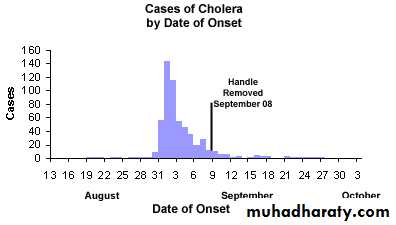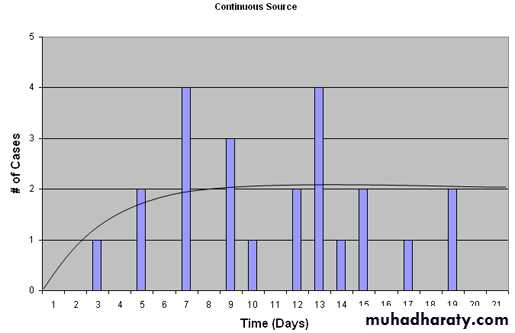APPLICATION OF EPIDEMIOLOGY TO COMMUNICABLE DISEASES
Dr Ali Abid SaadoonAssistant professor /community medicine department/ ThiQar medical college
EPIDEMIC: CONCEPT AND INVESTIGATION
Definition: The occurrence of an illness, in the community or region, in clear excess of normal expectancy and the cases are related to each other and derived from a common or propagated source. Alternatively, it may be defined as a substantial increase in the incidence rate of a disease in a specified population or region over a specified period.The term excess means that a public health emergency is created which needs urgent action. A single case of smallpox anywhere in the world is considered as an epidemic, because the normal expectancy of smallpox is zero.
Causes of epidemics:
Introduction of a new disease agent into susceptible populationDeterioration of environmental conditions. Such deterioration may facilitate disease agent transmission and reactivation of an already existing agent or agents.
Change in population immunity with increased susceptible pool.
Any combination of the above factors
Epidemic Curve
An epi curve is a visual display of the onset of illness among cases associated with an outbreak.can learn a lot about an outbreak from an epi curve, such as
The outbreak's time trend, which is the distribution of cases over time
Outliers, that is, cases that stand apart from the overall pattern
General sense of the illness magnitude
Inferences about the outbreak's mode of spread
The most likely period of exposure
In a point source outbreak of a known disease, you also can use the epi curve to identify the most likely time period of exposure that led to the outbreak. Knowing the period of exposure allows you to focus your search for the source of the outbreak.
Dynamics of epidemics
Two factors determine the shape of an epidemic pattern:
The relative frequency of the incubation periods of reported cases
The duration of exposure to the source of infection.
Sources of epidemic
According to the interaction of these two factors, we may have the following types of epidemics:Common source: which is either point source (the exposure to a single source of disease is brief and simultaneous and all the resultant cases develop within one incubation period (they all develop between the minimum and maximum incubation period) A point source epidemic occurs when a group of people is exposed to a single common source of infection at a single place and time. There is no significant transmission between individuals. continuous and intermittent epidemics
extended source
the exposure is also to a single source but it extends for a time and the resultant cases continue to appear beyond one incubation period.(A continuous epidemic occurs when a group of people is exposed to a single common source of infection at a single place for a continuous time period. There is no significant transmission between individuals. cf. intermittent and point source epidemics.)
The graph above from a hepatitis outbreak is an example of a point source epidemic. The incubation period for hepatitis ranges from 15-50 days, with an average of about 28-30 days. In a point source epidemic of hepatitis A you would expect the rise and fall of new cases to occur within about a 30 day span of time, which is what is seen in the graph below.
The epidemic curve below is from the cholera outbreak in the Broad Street area of London in 1854 that was investigated by Dr. John Snow. Cholera has an incubation period of 1-3 days, and even though residents began to flee when the outbreak erupted, you can see that this outbreak lasted for more than a single incubation period. This suggests an ongoing source of infection, in this case the Broad Street pump
Propagated source epidemic:
In this type a serial transmission of cases takes place until susceptible are exhausted or control measures are in effect. A (propagated epidemic occurs when an infection is spread from person to person (either directly or via a vector).Other relevant concepts:
Outbreak: an acute short epidemic such as an outbreak of food poisoningPandemic: an epidemic, which involves more than one country
Endemic: The constant presence of a disease or its causative agent in a defined geographical area. An endemic disease may show epidemic waves every now and then. Measles for example is an endemic disease in many populations with epidemics every 3-4 years. Immunization against measles, of course, has modified very much such pattern.
Investigation of an epidemic
There is a systematic method to investigate an epidemic as in case of an epidemic of typhoid fever or meningitis or hepatitis or any other disease:Verification of the diagnosis: It is important to make sure that the cases under investigation are definite cases of that disease. This is done by careful history, physical examination, and relevant laboratory investigation. For example, blood culture in typhoid fever is very reliable diagnostic method.
Cont.
Confirmation of the existence of epidemic (excess cases above normal expectancy): This is ascertained by comparing the reported cases at the time of the epidemic with cases reported in previous months or years.Identification of the affected cases and their characteristics: This is important because, it may help to identify a common experience or exposure of the cases and thus to facilitate the identification of source of epidemic
cont.
Further investigation of the population at risk, contacts, carriers and hidden casesStudy of the environment to identify factors, which are likely to be related to the epidemic. Search for any change in the environment at or immediately before the onset of the epidemic
Formulation of hypotheses about the epidemic regarding source of infection, mode of transmission and existence of reservoir of infection and carriers.
Cont.
Management of the epidemic: This includes :Treatment of cases and carriers
Protection of high risk and susceptible persons by immunization and chemoprophylaxis
Writing a report about the epidemic
Continuous surveillance to prevent future epidemics
Experimental verification of agent of the disease and mode of transmission










